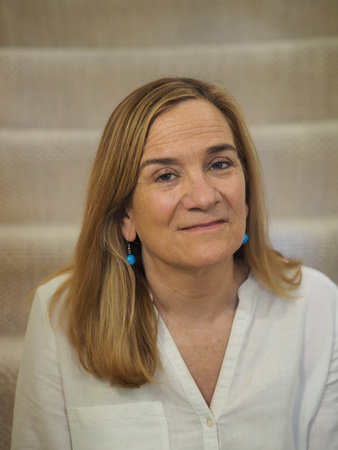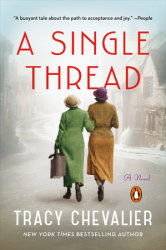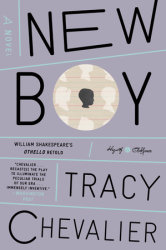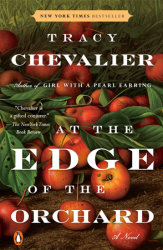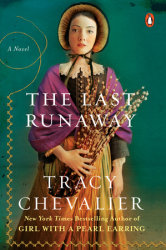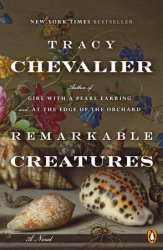If you were asked to adapt one of Shakespeare’s plays into the form of a novel, which would you pick, and how would you do it? That is the task a few of today’s bestselling novelists have been tasked with by Hogarth, for the Hogarth Shakespeare series. A few adaptations that have hit shelves so far: Hag-Seed by Margaret Atwood (The Tempest), Vinegar Girl by Anne Tyler (The Taming of the Shrew), Shylock Is My Name by Howard Jacobson (The Merchant of Venice), and The Gap of Time by Jeanette Winterson (The Winter’s Tale).
In New Boy, Tracy Chevalier transplants the tale of Othello to a 1970s suburban D.C. schoolyard. Othello becomes Osei Kokote, the son of a diplomat enduring his fifth first day at school in five years, and Desdemona becomes Dee, the golden girl of the sixth grade. Dee is drawn to Osei like a moth to a flame, while the rest of her grade is repulsed – this all-white elementary school in D.C. isn’t warm to outsiders, and a young boy from Ghana is about as other as you can get. But Desdemona is entranced, and, well, you know the rest. Read on to hear from Chevalier about the adaptation, the influence classic lit has had on her career, and why she chose Othello.
PENGUIN RANDOM HOUSE: This certainly isn’t the first time you’ve taken a cue from classic literature, or art of the past. Among other works, last year you edited an anthology inspired by Charlotte Bronte’s infamous line, “Reader, I married him,” from Jane Eyre. Do you find yourself naturally gravitating towards the classics when working on your own writing?
TRACY CHEVALIER: It’s not deliberate. In both instances – Shakespeare and Jane Eyre – I was asked, and a commission is quite different from a natural inclination. Having said that, I do look to the past a lot for inspiration, and that is where most of the classics – whether books or paintings or tapestries or poets – lie.
PRH: What role has classic literature played in your development as a writer?
TC: When I write I’m very aware of the weight of the many writers from the past whom I’ve read and loved. Much of a writer’s training comes from reading good books of all sorts, and I have read a lot of classics that have stayed with me, even if I don’t necessarily write like them. (I’m a terrible imitator. I’ve lived in London for over 30 years, and my British accent is laughable.) Some examples: George Eliot’s Middlemarch; Portrait of a Lady by Henry James; The Sound and the Fury by William Faulkner. All stupendous books, but I don’t write like any of them.
PRH: Were you given your choice of Shakespeare’s plays to adapt? Why Othello?
TC: I could choose from those that hadn’t been already taken (so not The Winter’s Tale, The Merchant of Venice, The Taming of the Shrew, or The Tempest). I chose Othello because I was drawn to the idea of how we treat outsiders. I’ve lived as an American in London for many years, so outsider stories appeal to me. Of course I have not suffered the abuse that Othello does both from the society around him and also specifically from Iago.
PRH: How did you first approach adapting Othello? How did you come to the decision to repurpose it into a schoolyard setting?
TC: I could set the story anywhere where someone is different from the people around him/her. So I could have written about an Arab in Israel, for instance; or someone from New York in Alabama; or a Japanese person in China; or a young person in an older community. The possibilities were endless, and at first that scared me. Then I was at a party and someone asked me if I chose Othello because I was particularly interested in race issues, and I said, “Well, as a kid I went to schools that were mostly black and I was the minority, so maybe that’s part of it.” And then the lightbulb lit and I thought: Playground! It makes a lot of sense. Playgrounds are definitely places where otherness is challenged, and kids are trying out the behavior they’ve seen in adults. The Othello story fit very easily into a school setting.
PRH: What was your greatest challenge in adapting Othello?
TC: Well, the greatest challenge I ducked early on – I decided not to try to imitate Shakespeare’s incredible use of language: it would be impossible and sound ridiculous. I stuck with the story. The biggest challenge was untangling some of the more baroque subplots and modifying or doing away with them. Shakespeare had to fill three hours with entertainment, and those subplots are visual filler that doesn’t quite work in a novel. Oh, and I also felt his female characters – primarily Desdemona and Emilia – weren’t give enough time and space, and so I made their characters stronger and more vocal.
PRH: Why are Shakespeare’s plays still widely consumed today, both in their original and adapted forms? Why will they continue to be?
TC: The stories continue to speak to us now. They’re about jealousy and discrimination (Othello), the break-down of family relations (King Lear), a son who can’t stand his stepfather (Hamlet), a man who can’t bear to see his daughter grow up (The Tempest), lovers whose families disapprove (Romeo and Juliet). You can find those stories on TV every night. Add to the stories the beauty of the language, and you’ve got a winning combination.
